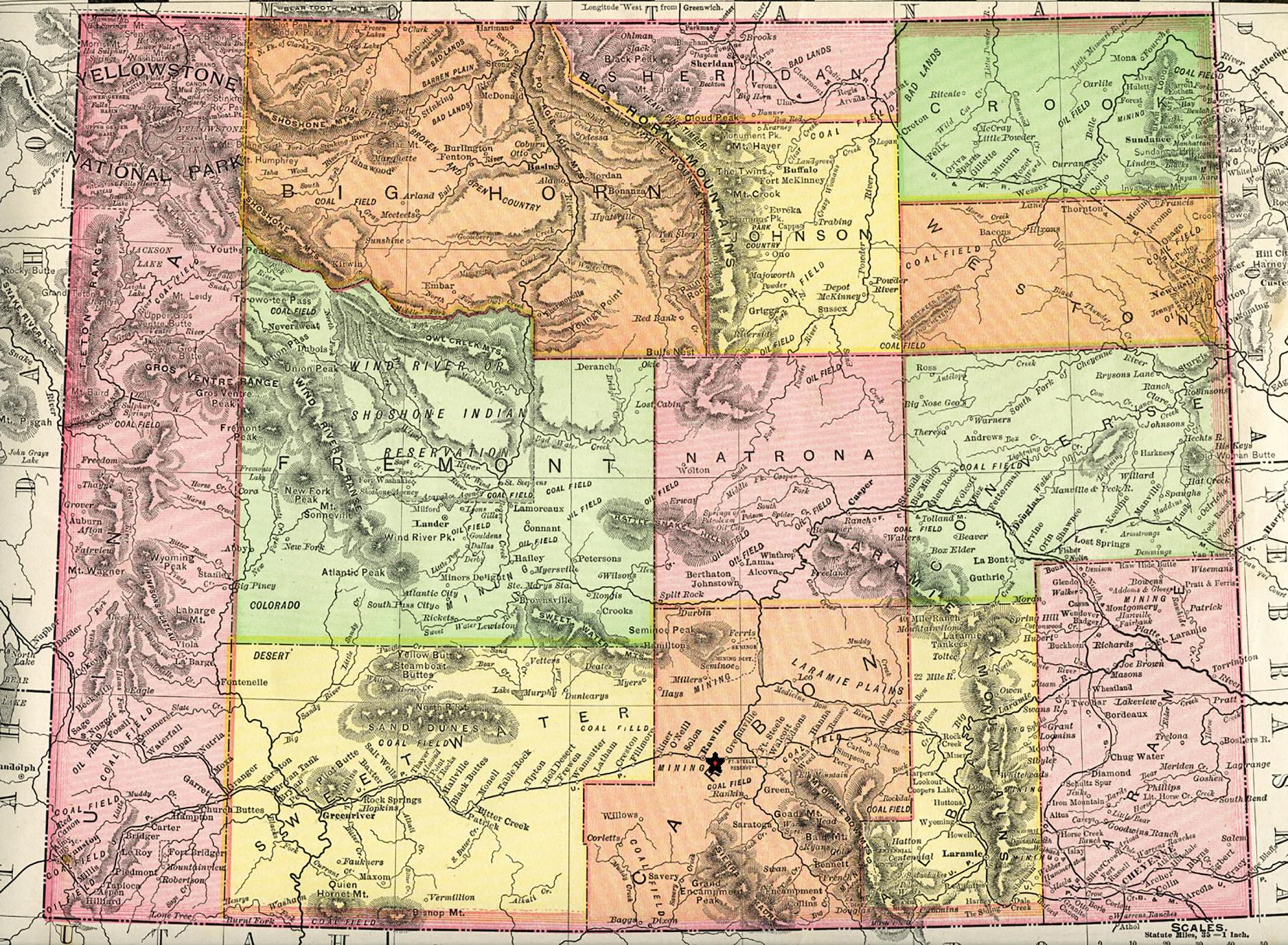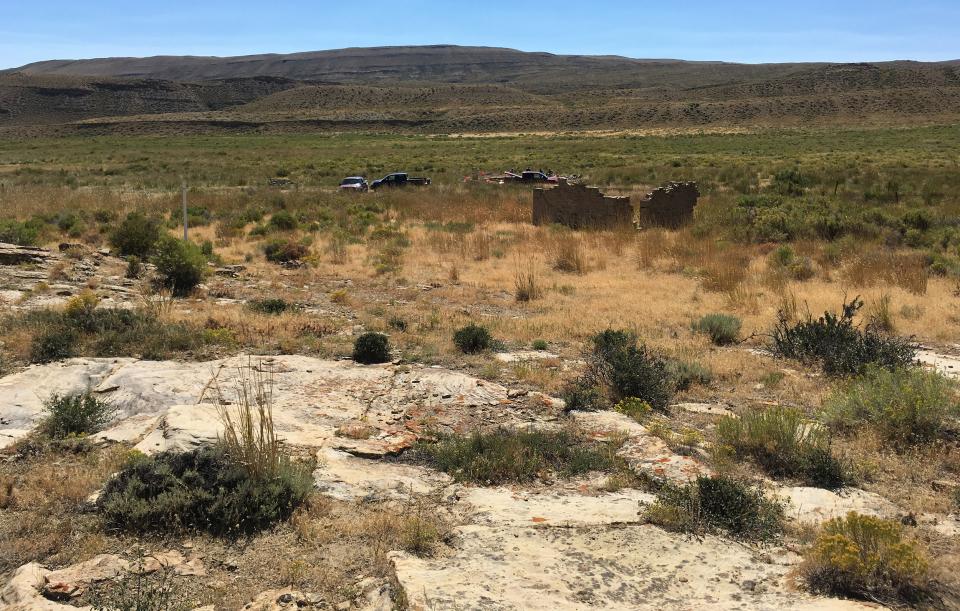- Home
- Encyclopedia
- The Frank Nevin Homestead, Carbon County, Wyoming
The Frank Nevin Homestead, Carbon County, Wyoming
About 1890 Frank Nevin, Confederate veteran, established a small, 160-acre homestead southeast of Rawlins, Wyoming. For 10 years he and his family had a garden and ran a small herd of cattle there, at a time when the earlier open range system was fast disappearing and small, family-run operations were becoming common. Recent archaeological excavations at the site support earlier historical conclusions about these changes on the range.
The Nevin Homestead, six miles southeast of Rawlins, included a ranch house, barn, root cellar, irrigation ditches, vegetable gardens, stock ponds and dams (Figure 2). It began as a family-run operation with work done by Nevin, his wife Mary and their children. The ranch produced meat, dairy products, vegetables and eggs. The ranch largely served the needs of the Nevin family with any surpluses sold to local markets including Rawlins and the Platte River valley.
The homestead was also a stage station along a wagon road from Rawlins to Saratoga and Grand Encampment, Wyoming and the gold fields of the Medicine Bow Mountains. The Nevin family remained at the homestead until 1899 when he sold the ranch and they moved to Saratoga. Next, two large Carbon County livestock outfits acquired the homestead: the Rawlins Livestock Company between 1899 and 1902 and the Kindt Sheep Company from 1902 to 1945. The Nevin Homestead saw continued use into the 1920s but was eventually abandoned. There were hundreds, perhaps thousands of these small, family-run livestock operations across Wyoming in the late 19th and early 20th centuries.
Open range ranching
The Nevin Homestead is significant for the time period it was occupied. In the 1870s and 1880s, the open-range system dominated stock-raising in Wyoming. Originating in Spain, it was introduced into North America through Hispaniola and Mexico. It reached its ultimate form in Louisiana and East Texas in the early 19th century and expanded across the northern plains after the Civil War.
Open-range ranching depended on access to large, unfenced areas of free public grazing land. Cattle were allowed to graze year-round with little herd maintenance other than spring and fall roundups. Growing hay for winter feed was not part of the open range system. With little herd oversight, managers of large cattle operations often had only a vague idea of the actual size of their herds or what effect cattle were having on the range.
Bad winters in 1886-1887 in eastern Wyoming and 1889-1890 in western Wyoming showed that cattle operations were exceeding the carrying capacity of the range. When no winter feed was available, the resulting winter herd mortality—combined with excessive debt from over-expansion—forced many of the largest open range ranches to retrench or go into bankruptcy.
The Midwest cattle tradition
With the collapse of the open range tradition in the late 1880s the small-to medium-sized ranches which survived had to adapt to changing economic and ecological conditions. A new pattern of ranching, labeled the Midwest cattle tradition, replaced the open range tradition across Wyoming. The Midwest tradition originated in the British Isles and entered into North America through Jamaica, South Carolina and the Ohio River Valley. The Midwest tradition emphasized increased herd maintenance which included hay meadows for winter feed, something the open range tradition largely ignored.
Another aspect of the Midwest cattle tradition was the introduction of British stock including Herefords, Angus and Durham cattle, which were bred together or with Texas Longhorns to produce a hardier, heavier strain of cattle. This began along the Oregon Trail in the 1840s and continued through the 1870s and 1880s. The trend accelerated in the 1890s as longhorns vanished from Wyoming ranches.
Image
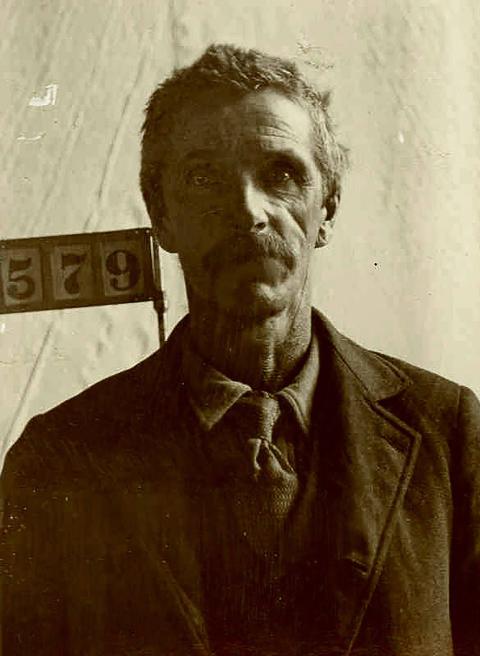
The overall number of cattle dropped dramatically during the 1890s while the number of ranches increased, indicating that average herd size declined. The number of cattle on Wyoming ranges fell from 934,000 in 1890 to 561,000 in 1900, a decline of 40 percent. Sheep became more prominent in the 1890s, augmenting or replacing cattle in many operations.
At the same time, the number of farms in Wyoming doubled between 1890 and 1900 and nearly doubled again between 1900 and 1910, rising to about 11,000. Small farms and ranches typically practiced subsistence agriculture. Meat, dairy and farm produce supplied the needs of the immediate family. They sold any surpluses at local markets.
Frank Nevin
Frank Nevin was born in Louisville, Kentucky, in 1837 of Irish ancestry (Figure 3). He attended the University of Virginia, but his field of study is unknown. During the Civil War he fought for the Confederacy. His obituary indicated that he rode with John Hunt Morgan, a Confederate raider who led an unsuccessful invasion of Indiana and Ohio in 1863 that resulted in most of his troops being killed or captured.
In 1905 Nevin, wearing his Confederate uniform, attended the encampment of the Grand Army of the Republic, the Union Army veterans organization, in Denver, which marked the 40th anniversary of the end of the Civil War. An unnamed Confederate who might have been Nevin marched along with Union veterans in the grand parade in his Confederate uniform.
After the end of the Civil War, Nevin, working as a carpenter, moved west. He arrived in Laramie, Wyoming in 1882 and Rawlins in 1884 where he originally operated a wagon repair shop. Frank and his wife Mary were wed in Laramie in 1882 and had nine children, seven of whom were born before or during the time they occupied the homestead. The children included William Francis (b.1883), David Bernard (b. 1885), Isabel (b.1887), John Henry (b. 1889), Raymond Arthur (b. 1893), Florence A., (b. 1895), Bessie (b. 1898), Joseph Merlin (b. 1900) and Kathrin (b. 1907). All the children except for Joseph Merlin and Kathrin lived at the homestead. Another Nevin child died in infancy.
Nevin establishes his homestead
Image
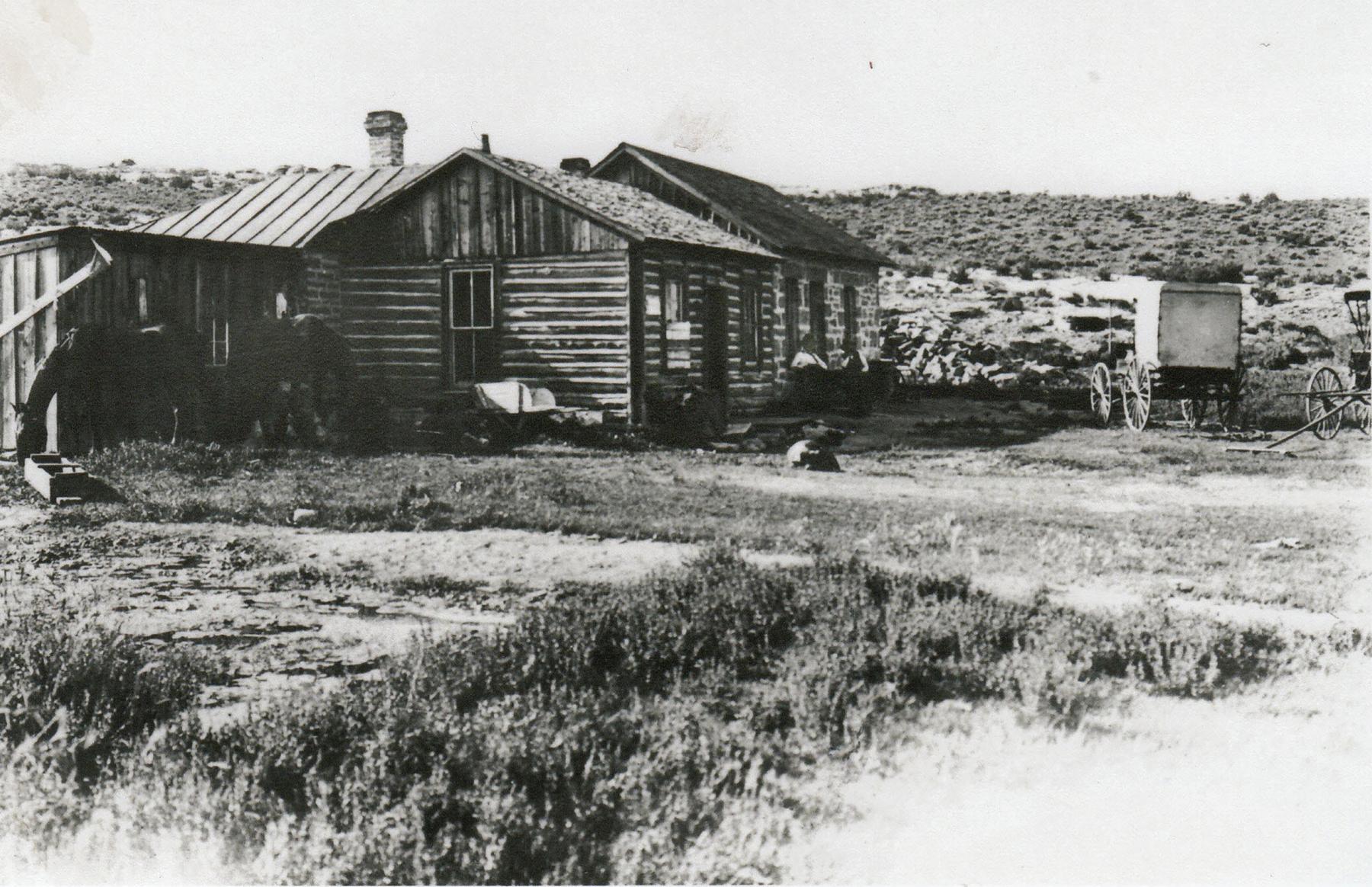
Nevin established his homestead in 1890 (Figure 4). During his 10 years at the homestead Nevin ran a small cattle ranch. The description of a 1901 sheriff's sale—two years after he moved to Saratoga—indicates the approximate scale of his cattle operation. His assets included one bull, eight cows, four yearling heifers, four calves, one large Schuttler wagon, one spring toothed harrow, one hand seed drill, one mowing machine, one two-horse hay rake and one saddle. This would suggest that the 17 cattle and calves sold at the sheriff’s sale were Nevin’s entire herd at that time. No sheep were listed in 1901 although in 1895 Nevin purchased—or perhaps stole—nine sheep. The farming equipment showed that Nevin was also growing crops and raising hay.
Legal problems
One aspect of ranching in Wyoming in the 19th century was that small ranchers were frequently accused of rustling cattle, particularly by the large ranchers. How often this really occurred continues to be hotly debated by historians.
In the 10 years Nevin lived at his homestead, he was accused of livestock theft four times. He was convicted in 1891 of selling veal without exhibiting the hide. He paid a $25 fine. In 1895 Nevin was accused of stealing nine sheep. He was convicted but the conviction was later overturned. In 1897 he was accused of stealing and killing a cow and a separate calf. The case was eventually dismissed.
Finally, in 1899, he was accused of stealing and butchering a cow. The case went to trial in 1901 and Nevin was convicted and spent three years in the state penitentiary in Rawlins, from 1901 to 1904. To pay for his legal defense, he took out a mortgage which he could not repay. His cattle and farm equipment were sold at the sheriff's sale to cover the debt.
Breeding cattle, and raising other livestock
Nevin clearly was interested in improving the quality of his beef cattle. By 1900 he was breeding red and black polled Angus heifers with a purebred Durham bull. These were likely the cattle sold at the sheriff’s sale in 1901 with the exception of one Angus heifer, which wolves killed in January 1900.
At the same time Nevin was improving the quality of his beef cattle, he was developing a dairy herd. In 1895 Nevin’s two eldest sons, William Francis, 12, and David, 10 died in an unexpectedly strong September blizzard while attempting to locate missing cows that needed milking. After moving to Saratoga in 1901, Nevin attempted to start a dairy operation with a herd, milking and dairy processing equipment and a market garden to grow produce for sale. His incarceration in the State Penitentiary ended this endeavor.
Beef and dairy cattle were not Nevin’s only food resources. The family raised Imperial White Pekin ducks, selling a setting of 12 eggs for $1.50 and thoroughbred Plymouth Rock chickens, selling a setting of 13 eggs for $1.25. Nevin also sold Belgian rabbits which were large, easy to raise and feed. Agricultural produce was also a part of Nevin’s food production. In October 1891 his wife Mary traveled to Rawlins with fresh vegetables for sale. In August 1897 Nevin produced a sample crop of pink turnips. He intended to plant more in his garden the following year.
The stage station
In addition to being a ranch, the Nevin Homestead served as a stage station on a stagecoach and freight-wagon road from Rawlins, south to Saratoga and Grand Encampment and gold mines in the Medicine Bow Mountains. The Rawlins-to-Saratoga Road was first developed in the early 1880s following the opening of the Saratoga spa and hot springs. The road saw renewed use in the early 1890s with the discovery of gold in the Gold Hill District in the Medicine Bow Mountains and in the late 1890s with the Grand Encampment copper boom. Nevin settled along this road in 1890 and was paid by Carbon County for making road improvements. The road was still in use as late as 1914.
Excavations
Archaeological excavations were performed by Western Archaeological Services of Rock Springs, Wyoming at the Nevin Homestead from July to September 2016. The author directed these excavations. Excavations centered on Feature 19, an area of rock cobbles exposed on the surface. The cobbles covered an area of approximately 8 x 8 meters (26 x 26 ft). Feature 19 was identified as the Nevin Homestead barn (Figure 5).
Image
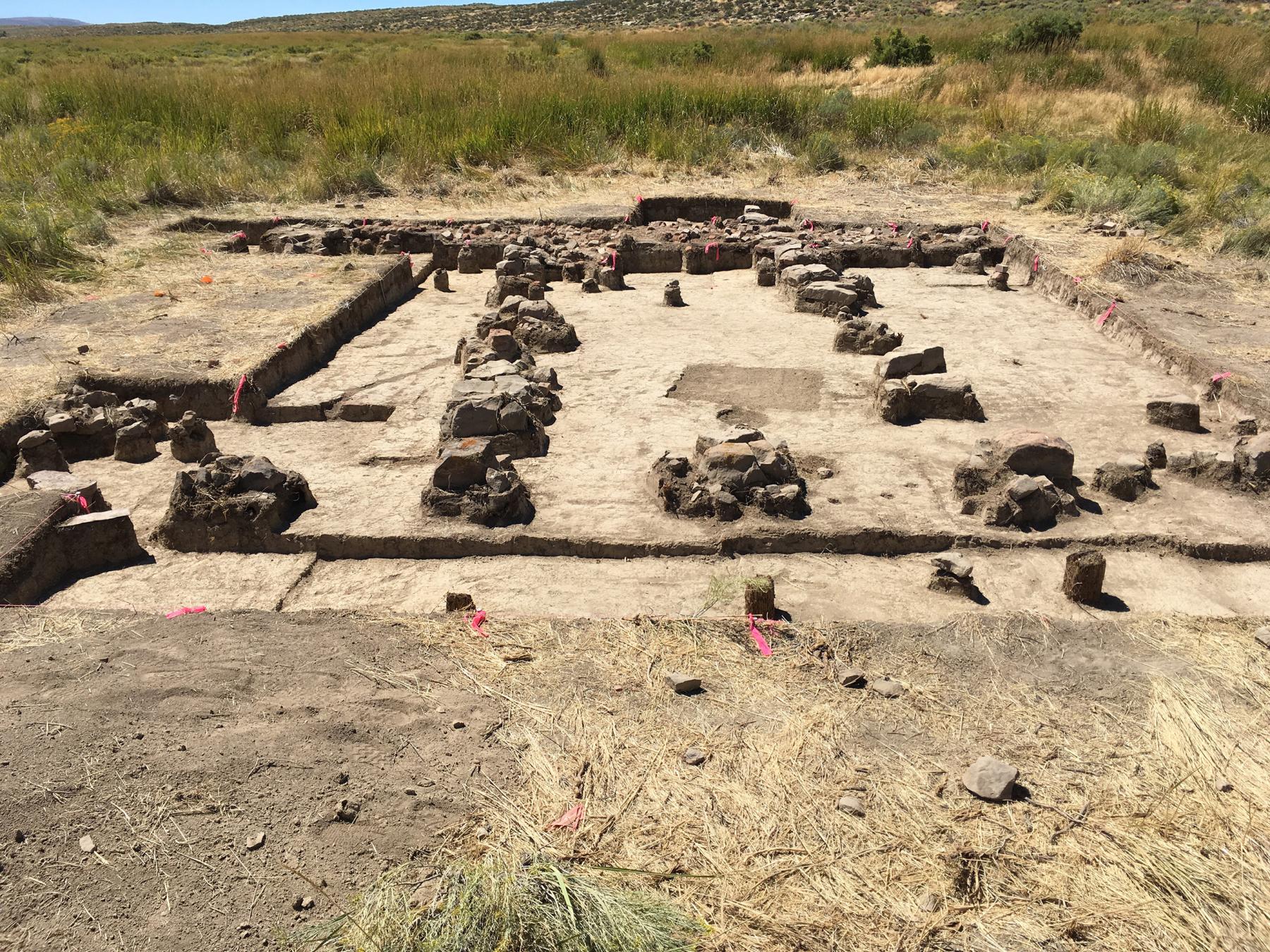
The remains of two buildings built one atop the other were identified. The lower building, designated Feature 19 Structure 1, contained no distinct structural remains. It was likely a log building similar to a section of the ranch house. It consisted of a layer of historic artifacts and building hardware approximately 15 to 20 cm. thick, capped by a 3-to 5-cm.-thick burn layer of charcoal overlying soil oxidized through exposure to high heat.
That is, Structure 1 was destroyed by fire. Partially melted glass indicates that the temperature of the fire exceeded 1000 degrees Fahrenheit. Temporally diagnostic artifacts indicate that the fire occurred on or after 1912 when the site was owned by the Kindt Sheep Co. Structure 1 dated to the Nevin, Rawlins Livestock and early Kindt Sheep Company occupation of the site.
A new building was quickly built on top of the remains of the original barn shortly after it burned down after 1912. This building is referred to as Structure 2 and dates to the later Kindt Sheep Company occupation of the site. The second barn consisted of four rows of individual dry-laid unshaped rock cobble clusters, three wooden post stubs and a linear brick feature. The cobble clusters were likely footers for roof support posts suggesting that the second barn was an early example of a pole barn where the weight of the roof was supported by interior vertical poles rather than load-bearing exterior walls. No internal or external foundations or wall remains were noted.
A 10-to-15-cm.-thick layer of historic artifacts was present above the burn layer. The types of artifacts found in the second barn and their distribution across the excavation block were very similar to what was found in the first barn indicating that the functions of the two barns did not change. The second barn fell into disuse in the 1920s or 1930s and the wooden walls and roof were scavenged for use elsewhere.
The excavation at the historic Nevin Homestead Block produced the remains of two probable barn structures, 13,737 artifacts and 1,045 faunal specimens. Archaeological excavations recovered a suite of residential artifacts, personal artifacts, tools, equipment, hardware artifacts and faunal remains in both Structure 1 and Structure 2.
Image
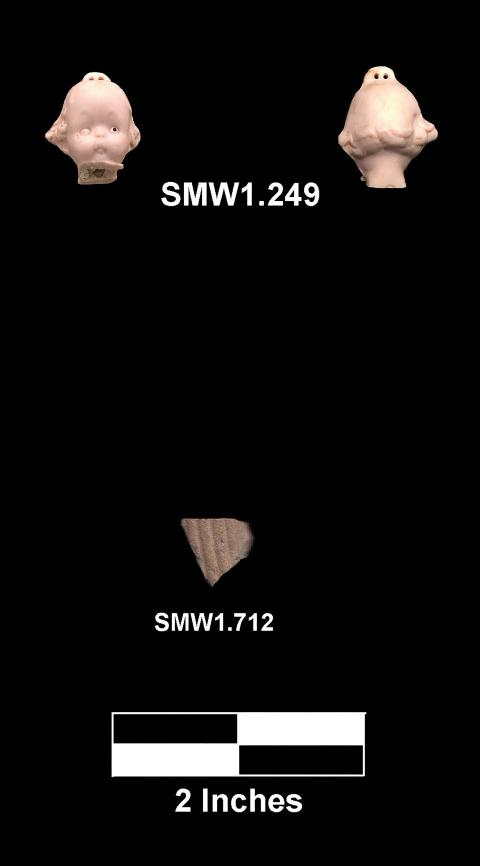
Artifacts included building hardware, bottle glass, tools and equipment, clothing buttons and agricultural items. Artifacts associated with children include a bisque porcelain doll’s head, a metal pram wheel and two children’s clothing buttons (Figure 6). The presence of artifacts which indicate residential, domestic faunal processing and storage of tools and equipment throughout the barns suggests continuity in the functioning of the structure up to the burning of Structure 1 and into the use of the subsequent Structure 2.
The presence of butchered and broken animal bone across the excavation block indicates that ranchers dressed and/or butchered domesticated sheep and cattle within Feature 19 Structures 1 and 2. Fetal bone specimens recovered from Structure 1 indicate the processing of a pregnant ewe in March, based on the development of the fetal bones over the five-month gestation period. That is, sheep typically give birth in late spring; the bones show that this ewe was butchered some two to three months prior to lambing.
Late winter was often a time of hardship in isolated settlements as winter supplies ran low. The presence of a large family would make this harder, and the need to butcher a ewe in March may reflect this hardship. This supports the practice of using homestead herd stock for subsistence.
There is no indication that Nevin produced food for regional or national markets although the Rawlins Livestock and Kindt occupations did. Game animals were virtually absent indicating that hunting was not a major source of protein at any time.
Nevin Homestead: historical significance
The Nevin Homestead was typical of small, late 19th and early 20th century livestock operations in Wyoming. It began as a small family-run cattle ranch which produced resources for its own use with any surpluses sold to local markets. The Nevin Homestead subsequently was absorbed into larger sheep and cattle operations that supplied wider markets.
What makes the Nevin Homestead historically significant is that it operated at a time of great change in Wyoming ranching. Historical sources suggest the transition from the open range to Midwest cattle tradition across Wyoming occurred almost immediately after the bad winters of the late 1880s. Historical and archaeological evidence from the Nevin Homestead supports this contention. Within three years of the bad winter of 1886-1887, the Nevin Homestead was beginning to show all the hallmarks of the Midwest system.
Some evidence suggests that the Midwest system may have been practiced by small- to medium-sized ranches in Wyoming prior to the bad winters of the late 1880s. When the Open Range system collapsed in the late 1880s and early 1890s, aspects of the the Midwest system were already in place, which explains the rapid transition within Wyoming ranches.
Noted Wyoming historian T.A. Larson wrote that cowboys and cattlemen in Wyoming in 1880 were rarely Texans, but were far more likely to be from the Midwest. Nevin, being from Kentucky, fits this pattern. If historical and archaeological studies of small ranches and homesteads show that Midwest cattle tradition attributes were present at this type of site in the 1880s, then the Nevin Homestead would help explain the rapid transition from the 19th century open range system to the beginnings of ranching systems in wide use today.
[Editor’s note: Special thanks to Western Archeological Services, Inc., of Rock Springs, Wyoming, the author’s employer, and to the Wyoming Cultural Trust Fund, support from which in part made publication of this article possible.]
Resources
Primary Sources
- BYU Idaho
- Details for Marriage ID# 209616 William Franklin Nevin and Mary Fagan. Special Collections and Family History, Western States Marriage Collection. Accessed through Ancestry.com, January 10, 2017.
- Carmen, Ezra A., H. A Heath and John Minto.
- Special Report on the History and Present Condition of the Sheep Industry of the United States. U.S. Department of Agriculture, Bureau of Animal Industry. Government Printing Office, Washington D.C. 1892
- United States Department of Agriculture. Lantz, David E., Raising Belgian Hares and Other Rabbits. Government Printing Office, Washington, D.C., 1912.
- United States Bureau of the Interior, Bureau of Land Management. Government Land Office Records, accessed July 15, 2024 at http://glorecords.blm.gov.
- Wyoming newspaers accessed January-April 2017, February 2024 via https://wyomingnewspapers.org/:
- Carbon County Journal, Rawlins, Wyoming:
- Saturday, May 16, 1885, page 3, column 6.
- Saturday, Oct. 3, 1891, page 3, column 3.
- Saturday, Sept. 28, 1895, page 3, column 6.
- Saturday, Feb. 12, 1898, page 4, column 3.
- Saturday, March 5, 1898, page 3, column 4.
- Saturday, March 12, 1898, page 3, column 6.
- Saturday, July 29, 1905, page 4, column 4.
- Saturday, Sept. 19, 1913, page 2, column 1.
- Laramie Weekly Sentinel. Saturday, March 22, 1884, page 1, column 3.
- The Miner, Hudson, Wyoming. Friday, Dec. 19, 1913, page 1, columns 1 and 2.
- Platte Valley Lyre, Saratoga, Wyoming. Thursday, March 21, 1889, page 6, (incomplete).
- ______________. Thursday, March 15, 1894, page 1 column 4.
- ______________. Thursday, Sept. 26, 1895, page 4, column 2.
- ______________, Thursday, Aug. 5, 1897, page 1, column 2.
- Rawlins Republican, Thursday, April 23, 1891, page 1, columns 5 and 6.
- ________________. Friday, Sept. 27, 1895, page 1, column 2.
- ________________. Friday, Jan. 29, 1897, page 2, column 2.
- ________________. June 18, 1904, page 4, column 2.
- ________________. Sept. 13, 1905, page 1, column 3.
- ________________. March 14, 1906, page 4, column 2.
- Rawlins Republican. (Illustrated) Friday, July 2, 1897, page 11, columns 2 and 3.
- Rawlins Republican. Wednesday, Dec. 15, 1897, page 1, column 2.
- ________________. Saturday, July 8, 1905, page 2, columns 3 and 4.
- ________________. Aug. 7, 1914, page 1, column 1.
- ________________. Sept. 18, 1914, page 1, column 1.
- Rawlins Semi-Weekly Republican. Wednesday, March 23, 1898, page 1, column 4.
- ___________________________. Wednesday, April 16, 1898, page 4, column 3.
- ___________________________. Wednesday, June 11, 1898, page 4, column 2.
- ___________________________. Wednesday, Dec. 21, 1898, page 1, column 2.
- ___________________________. Wednesday, June 21, 1899, page 1, column 1.
- ___________________________. Wednesday, Sept., 1899, page 2, column 4.
- ___________________________. Wednesday, Nov. 22, 1899, page 1, column 4.
- ___________________________. Wednesday, July 3, 1901, page 1, column 3.
- ___________________________. Saturday, Jan. 23, 1904, page 4, column 3.
- Saratoga Sun. Oct. 1, 1891, page 2, column 3.
- __________. Feb. 25, 1897, page 1, column 2.
- __________. Nov. 4, 1897, page 1, column 3.
- __________. Jan. 25, 1900, page 1, column 1.
- __________. Jan. 31, 1901, page 1, column 3.
- __________. April 4, 1901, page 4, column 3.
- __________. June 20, 1901, page 1, column 2.
- __________. Thursday, July 11, 1901, page 4, column 3.
- __________. Thursday, Nov. 14, 1901, page 1, column 2.
- __________. Thursday, Nov. 21, 1901, page, 1 column 4.
- Wyoming Commonwealth. May 3, 1891 page 2, columns 1 and 3.
- Castle Rock Journal (Colorado). Friday, Sept. 15, 1905, page 2, columns 5 and 6. Castle Rock Colorado, accessed July 15, 2024 at www.coloradohistoricnewspapers.org.
- Herald Democrat (Leadville, Colorado). Thursday, Sept. 7, 1905, page 1, column 4, accessed July 15, 2024 at www.coloradohistoricnewspapers.org.
Secondary Sources
- Anderson, C., R McElhoe, M. Dedrow and J. Smith. Wyoming Cultural Properties Form for 48CR9097. Document on file, Wyoming State Historic Preservation Office, Cultural Records Division, Laramie, Wyoming, 2008.
- Baer, Sarah, Nicole Kromarek, Vanesa Zietz, Jason Burkard, Jennifer Long, Thomas Witt, Scott Phillips, John Kennedy and Norma Crumbley. Class III Cultural Resource Inventory of the Chokecherry and Sierra Madre Wind Energy Project, Site-Specific Plan of Development 3: The Road Rock Quarry, Carbon County, Wyoming. Prepared for the Wyoming Bureau of Land Management, Rawlins Field Office, by SWCA Environmental Consultants, Broomfield, Colorado, 2013.
- Baird, LeAnne. National Register of Historic Places Nomination for the Halleck Creek Historic District. Document on file, Wyoming State Historic Preservation Office, Cultural Records Division, Laramie, Wyoming, 1973.
- Baker, Steven G., Duane Smith and Martha Sullenberger-Fry. “Victorian Mining Settlements.” In Colorado History: A Context for Historical Archaeology. Church, Minette C., Steven G. Baker, Bonnie J. Clark, Richard F. Carrillo, Jonathon C. Horn, Carl D. Späth, David R. Guilfoyle and E. Steve Cassells. Denver: Colorado Council of Professional Archaeologists, 2007.
- Barnes, Frank C. Cartridges of the World. Chicago, 1980: Follet Publishing Company.
- Baxter, R. Scott. “Industrial and Domestic Landscapes of a California Oil Field.” In Communities Defined by Work: Life in Western Work Camps. Society for Historical Archaeology 36, no. 3, 2002.
- Cassity, Michael. Wyoming Will Be Your New Home…Ranching, Farming and Homesteading in Wyoming, 1860-1960. Wyoming State Historic Preservation Office, Wyoming State Parks and Cultural Resources., Cheyenne, Wyoming 2011.
- Fike, Richard E. The Bottle Book: A Comprehensive Guide to Historic, Embossed Medicine Bottles. Caldwell, New Jersey: The Blackburn Press, 1987.
- Johnson, David E. and Robert Ficenec. Data Recovery Excavations at the Nevin Site (48CR9097) for Power Company of Wyoming Chokecherry and Sierra Madre Wind Energy Project, Carbon County, Wyoming, (16-WAS-008). Western Archaeological Services, Rock Springs, Wyoming, 2018.
- Jordan, Terry G. North American Cattle-Ranching Frontiers: Origins, Diffusion and Differentiation. Albuquerque: University of New Mexico Press, 1993.
- Kromarek, Nicole, Vanesa Zietz, Sarah Baer and Norma Crumbley.
- Class III Cultural Resource Inventory of the Chokecherry and Sierra Madre Wind Energy Project, Phase I Haul Road and Facilities, Site-Specific Plan of Development, Carbon County, Wyoming: Volume 2. Prepared for the Wyoming Bureau of Land Management, Rawlins Field Office, by SWCA Environmental Consultants, Broomfield, Colorado, 2014.
- Larson, Taft A. History of Wyoming. Lincoln: University of Nebraska Press, 1978, 194.
- Lockhart, Bill. “The Color Purple: Dating Solarized Amethyst Container Glass. Historical Archaeology 40, no. 2, (2006): 45-56.
- Lockhart, Bill, Pete Schulz, Bill Lindsey, Carol Serr, David Whitten and Beau Schreiver. The American Bottle Co.: A Study in Contrasts and Contradictions. Historic Glass Bottle Identification and Information Website, accessed July 12, 2024 at www.sha.org/index.htm.
- Retter, Michael J., Vanesa Zietz, Tate Wylie, Paul Burnett and Scott C. Phillips.
- Testing Results and Research Design for Data Recovery at 48CR9097 and 48CR10089 Associated with the Chokecherry and Sierra Madre Wind Energy Project, Carbon County, Wyoming. Prepared for the Power Company of Wyoming. SWCA Environmental Consultants, Broomfield, Colorado, 2015.
- United States Bureau of Land Management, Rawlins, Wyoming field office. Bies, Michael. IMACS Site Form for the Ferris Haggarty Mine Tramway, 1985.
- United States Bureau of Land Management/Society for Historical Archaeology.
- Historic Glass Bottle Identification and Information Website, accessed July 12, 2024 at www.sha.org/index.htm.
Illustrations
- The 1895 map of Wyoming is from the collections of Mike Cassity. Used with thanks.
- The prison photo of Frank Nevin is from the Penitentiary Inmate records at Wyoming State Archives. Used with permission and thanks.
- The 1890s photo of the ranch house on the Nevin homestead is courtesy of Robert Shirkey. Used with thanks.
- The other photos are from Western Archeological Services, Inc., in Rock Springs, Wyoming. Used with permission and thanks.

